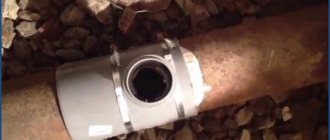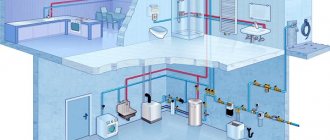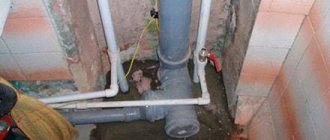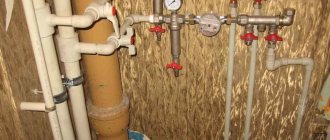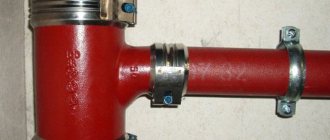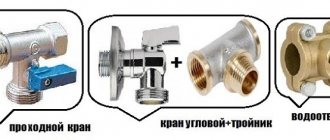The cast iron tee is one of the main elements of the sewer system.
It is an adapter that connects three pipes; by the way, one of them has a smaller diameter than the others.
This device is installed in places where the pipeline acquires several directions.
Many people wonder whether it is possible to replace a cast iron sewer tee? Practice shows that this can be done, but it is quite difficult with your own hands. Firstly, the technical process itself is quite complicated, and secondly, this type of repair of sewer pipes will require expensive tools. Well, in general, it is quite possible to replace this part of the system, because it is not cast together with the pipe.
This is what a cast iron tee looks like
Replacing a tee using an angle grinder
Dismantling cast iron sewer
Replacing old piping is no easy task, especially when it comes to cast iron. The method of connecting the pipes plays a decisive role in the labor intensity of the process. The set of tools that will be used also depends on this. So, in order to carry out a more or less accurate repair of the sewer system, or more precisely, its complete replacement, you will need:
- grinder with cutting and grinding discs included;
- blowtorch;
- hammer and screwdrivers of various lengths, thicknesses, crosspiece;
- pipe wrench and chisel.
To completely dismantle a cast iron sewer, you will also need a hammer drill, a knife, a steel wedge, a chisel, a pipe cutter, and a crowbar. Do not forget that the first step is to determine how to connect the elements of the sewer system.
Hammer and pipe cutter
Pipeline selection and required tools
In old houses, all pipes were installed from cast iron, including sewer pipes. Of course, this is a very durable and reliable material, but it also has its shelf life. Therefore, sooner or later, the time comes when it needs to be replaced.
Modern risers are made from an even more durable material, which is also lightweight and outwardly more aesthetically pleasing. Masters recommend switching to this more practical material. Steel or galvanized pipes will need to be replaced again after ten to twenty years. But if you replace them with polypropylene or polyvinyl chloride, then their operation for up to thirty to fifty years is guaranteed. And often it stretches over an even longer period.
And if, along with the replacement, you also take care of good ventilation, which can be purchased complete with pipes, then you can simply forget about sewer odors.
Since it is necessary to replace a cast-iron sewer with a plastic one in a multi-story building, the water must first be shut off. Therefore, the work is done as quickly as possible.
Also, neighbors above are warned not to use the restroom and water, otherwise everything will be sent to your apartment, and the neighbors below will be flooded.
To dismantle the sewer riser, the following tools are required:
- Bulgarian;
- nail puller;
- a large screwdriver to remove small elements from the system;
- chisel;
- perforator;
- hammer;
- grinder;
- film for blocking the pipe hole;
- apron, gloves and glasses for personal protection.
Dismantling of old sewerage
Having decided to replace the riser yourself, it is best to negotiate with your neighbors so that, if necessary, they can provide access to the apartments. However, in most cases, replacement occurs exclusively in your apartment between the floor and ceiling.
Step-by-step instructions for removing the riser are as follows:
- A distance of ten centimeters from the ceiling surface and eighty from the tee is calculated. Two cuts are made with a grinder. The depth should be half the diameter of the pipe.
- A chisel is applied to the upper cut and hit with a hammer. Then repeat the same manipulation below. The blows must be applied with sufficient force to split the pipe so that the middle section is removed.
- The pipe from the ceiling is covered with a polyethylene film.
- When disassembling the lower part, consisting of the tee and other fittings, arm yourself with a nail puller or crowbar to loosen the fasteners. Then remove the fitting. But, basically, this requires additional work with a hammer drill. The cement on the fastenings is removed with it.
- Use a chisel or screwdriver to chip off the cement, and then remove the tee. If this does not work, the fitting is cut off with a grinder, retreating up to three centimeters from the socket.
- In the remaining areas, remove all contaminants and clean the cast iron using a grinding machine.
Pipe installation
After removing the old pipeline, you need to immediately install a new one so as not to cause unnecessary inconvenience to your neighbors. But they begin the process, like the previous one, by checking all the tools necessary for this.
For installation you will need the following equipment:
- pipes with a diameter of one hundred and ten centimeters;
- outlet tee made of the same material as the riser;
- rubber sealing collars to secure the fasteners between the protruding cast iron stumps and the plastic pipe;
- pipe for transition from cast iron to plastic and vice versa;
- pipe fastenings;
- soap used to facilitate entry into fasteners, that is, a kind of lubricant;
- vertical building level.
Installation occurs in the reverse order compared to dismantling:
- Rubber cuffs are inserted into a piece of pipe.
- Attach the adapter to the top and the tee to the bottom. All parts must be fastened as tightly as possible to ensure maximum tightness. When the tee moves freely, the connection is sealed using silicone sealant or flax winding.
- The plastic riser is secured with clamps. If the ceiling height is standard, then you usually get by with three pieces: for the top, bottom and middle. If it is high, then you need to purchase additional connections.
- The system is pre-assembled.
- A pipe must be lowered into the tee to connect the plastic and cast iron.
- Each fastener is lubricated with silicone sealant and wait for it to harden.
- Then turn on the water and check the pipe connections for leaks. If everything is in order, then this part of the work can be considered completed.
What to do if cast iron pipes are connected with sulfur
You can determine with what substance the pipeline was built using a blowtorch. If, when it is brought to the junction, the substance begins to melt, then it is definitely sulfur. The destruction process itself is divided into several stages:
- The pipe that is located farthest from the riser is the first to break. This is done with a hammer and continues until a crosspiece is found that needs to be loosened.
- At this time, you need to connect a blowtorch or gas heating pad. Under the influence of high temperatures, sulfur melts, and accordingly, it is possible to loosen the pipe. Before carrying out this procedure, you need to wear gloves to avoid burning your hands.
- After the sulfur has been removed, you can try to remove the cross from the riser.
This is what a blowtorch looks like
Who should carry out and pay for the work?
The person responsible for replacing the sewer system in an apartment building is determined based on the provisions of the regulatory documentation. The main regulatory documents are:
- rules for maintaining common property in an apartment building, approved by Government Decree No. 491 dated 08.08.2006;
- MDK 2-04.2004 Methodological manual on the maintenance and repair of housing stock;
- rules and regulations for the technical operation of the housing stock, approved by Decree of the State Construction Committee of the Russian Federation dated September 27, 2003 No. 170.
In accordance with regulatory documentation, responsibility for the maintenance, maintenance and repair of utilities lies with their owners. All branches from the sewer riser passing within the apartment are the property of its owners. Therefore, the replacement of a sewer line in an apartment building should be organized by the residents and carried out at their expense.
As for the riser, in accordance with the Rules for the maintenance of common property of the apartment building, it is common property. Therefore, its replacement must be carried out by the management company servicing the house. The same applies to the branch from the riser to the first connecting connection. Payment is made by the management company from the funds that residents contribute to the maintenance of the house. If a complete replacement of sewer risers in an apartment building is carried out on all floors, then it can be financed from funds transferred for major repairs.
It must be borne in mind that this procedure only applies if the communications are faulty, in disrepair or have reached the end of their service life. If a tenant plans to replace a working riser, for example, when renovating an apartment or remodeling a bathroom, then this work is carried out at his expense.
Description of the procedure for removing a cast iron sewer tee
A shaped piece of piping called a tee is located at the very bottom of the main riser. There are several ways to extract it. And it’s better to involve a professional in this. All cast iron tees for sewerage can be dismantled in three ways:
Breaking apart a cast iron tee with a screwdriver
- using a screwdriver and milk;
- by heating;
- using a grinder.
In the first case, you need to follow a certain order. First, you gently tap the tee. A gap should form between the pipe and the cross, into which a screwdriver can then be inserted and the tee removed.
Screwdriver and hammer
The second method is faster, but is accompanied by the release of an unpleasant odor. Most often, a gas heating pad or blowtorch is used when it is necessary to disassemble a connection with small diameter pipes. You can do this yourself, but if you don’t have experience, it’s better to hire a gas welder.
Gas welder services
The last method is to use an angle grinder. With its help, you need to cut off some parts of the tee and leave a small piece of pipe. After the remains of the product are cut, the socket is closed with a plug. The cut part of the cross is knocked out with a hammer. Finally, the treatment area is cleared of cast iron residues. It is worth noting that it is the last method of disassembling the tee that is the most practical and reliable, and does not require much time.
If after dismantling there is burning sulfur left on the crosspiece, then it must be lowered into a bucket of cold water, preferably made of iron. After the socket has cooled, you can begin installing a new riser made of plastic.
Installation of a plastic tee
Replacing cast iron sewer pipes time to dismantle
First stage. Using a pipe cutter, a vertical pipe is cut; if such a tool is not available, you can use a grinder. The cuts are made at a slight slope relative to each other and at a distance of 10-15 cm. The cuts should converge closer to the wall, but the pipe itself should remain ¾ uncut. This is necessary so that the upper part of the riser does not bend. Then a wedge is hammered in on both sides, after which you need to break out the cut piece as carefully as possible. Be careful not to let anything go down the drain.
Cutting the pipe with a pipe cutter
Replacing cast iron sewer pipes with plastic ones is the second stage. The top edge of the pipe is cut at a predetermined height. To make it easier to connect the plastic with the rest of the cast iron, a piece of pipe is left. Its height should be equal to the size of the connecting element. It is recommended to mark the cut line before cutting to ensure a smooth edge. After cutting the pipe, you need to hit it towards the wall, which will cause cracking.
This is how a plastic pipe is connected to a cast iron pipe
The third stage of dismantling consists of carefully rocking the lower part of the remaining pipe; it is very important not to damage the lower bell. If it lends itself to rolling, then you can begin to remove such components as couplings, revisions, and compensation pipes
Price issue
Replacing a sewer tee that will meet the requirements of GOST is a service that is in demand in the Russian Federation, and accordingly, it has its price. It is difficult to answer the question of price with utmost precision, because it depends on many factors. We are talking about the material used to make the new adapter that is planned to be installed. Just so you know, a propylene tee costs several times less.
The price of the service reflects:
- tee location;
- its diameter;
- current condition of pipes, etc.
The cost of the service is approximately 4000 rubles
Today, the cost of replacing a riser sewer pipe with a tee with a diameter of 110 mm is approximately 4 thousand rubles. Moreover, the price is not fixed and may vary depending on conditions.
